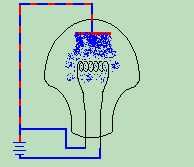


Lesson 57 - More AboutOscillators
Oscillators are found in nearly every type of circuit, so it is imperative that we understand how they work and can recognize them when we see them. Of course, the basic job of an oscillator is to generate a repeating signal, usually at a constant frequency. However, there are various methods that can be used to do that. We know basically, that the oscillator is an amplifier, with a tank circuit connected to it. The signal goes through the tank circuit, which sets the frequency, gets amplified, and the output of the amplifier is fed back into the tank circuit. The output is somehow controlled to keep the amplifier from going into runaway. There are several different types of oscillators. Let us begin with the easiest to understand. Armstrong OscillatorWe call this second output coil the "tickler coil". The tickler coil is the tell-tale component of the Armstrong Oscillator. All Armstrong Oscillators have a tickler coil. Now to explain the process in more detail. Please - follow the schematic with your finger as we go along. If you get lost, go back and start over. Understanding the Armstrong will make all the other oscillator circuits easier. Now we have a voltage drop across the grid capacitor, which with the tank positive and grid netagive begins to build a charge and continues building for at least one half cycle of oscillation. Note that the values of the grid resistor and grid capacitor are important to make sure this happens on schedule. If it does not, the oscillator will still work, but the waveform will be mis-shapen. (In case you've forgotten, you may want to review the section on RL and RC Time Constants.) Continuing in this manner, the grid swings negative when the tank swings positive. Likewise the grid swings (more) positive when the tank swings negative. This puts the grid 180 degrees out of phase with the tank circuit at all times. Since the input to any amplifier is always 180 degrees out of phase with the output of the amplifier, this 180° signal reinforces the incoming signal, causing what we call this "Positive Feedback". Sometimes Negative feedback is added to a circuit for purposes of gain control, but in the case of an oscillator, we need positive feedback. When the tickler coil (and plate) reach maximum voltage, and the cap can charge no more, the cap fires (hence - firing circuit) and the grid begins to swing positive. The positive swing on the grid causes the plate to swing negative, which in turn causes the tickler coil to swing negative, reversing the whole cycle. Tickler swings negative, tank swings negative, firing circuit fires a positive, grid goes positive, shuts off the tube causing a positive swing in the tickler coil. The cycle is endless. Note: The values of the coil and cap in the TANK circuit control the frequency of the oscillator. The values of the resistor and cap in the FIRING circuit control how long the cycle operates. If the resistor and cap in the firing circuit fire too quickly, you will have a distorted waveform (not a sine wave), but it will still have the frequency dictated by the tank circuit frequency. Hartley OscillatorBy tapped we mean that there are 3 contacts on the secondary of the coil. One at the top, one at the bottom, and the third one is somewhere in the middle. Instead of having a separate tickler coil, the secondary coil has both coils built into it. When B+ is applied to the plate, current flows through the tube, causing a current flow through the tickler coil. Energizing the tickler causes lines of flux to cross the tank circuit coil, and we have a situation similar to that in the Armstrong. The key difference in operation is that instead of the feedback being between the plate and grid - it is between the grid and the emitter respectively. Colpitts OscillatorNote - in almost any oscillator - it is possible to change the inductance of the coil, or the capacitance of the cap in order to tune the circuit - however in most cases, it is easier to change the capacitance than the inductance - so typically a tuned cap is used. In the particular case of the Colpitts - it is often a "ganged" cap where both capacitors move at the same time. 
|
| (On The Following Indicator... PURPLE will indicate your current location) | ||||||||||||||||||||||||
| 1 | 2 | 3 | 4 | 5 | 6 | 7 | 8 | 9 | 10 | 11 | 12 | 13 | 14 | 15 | 16 | 17 | 18 | 19 | 20 | 21 | 22 | 23 | 24 | 25 |
| 26 | 27 | 28 | 29 | 30 | 31 | 32 | 33 | 34 | 35 | 36 | 37 | 38 | 39 | 40 | 41 | 42 | 43 | 44 | 45 | 46 | 47 | 48 | 49 | 50 |
| 51 | 52 | 53 | 54 | 55 | 56 | 57 | 58 | 59 | 60 | 61 | 62 | 63 | 64 | 65 | 66 | 67 | 68 | 69 | 70 | 71 | 72 | 73 | 74 | 75 |
[COURSE INDEX] [ELECTRONICS GLOSSARY] [HOME]
| Otherwise - please click to visit an advertiser so they know you saw their ad! |
